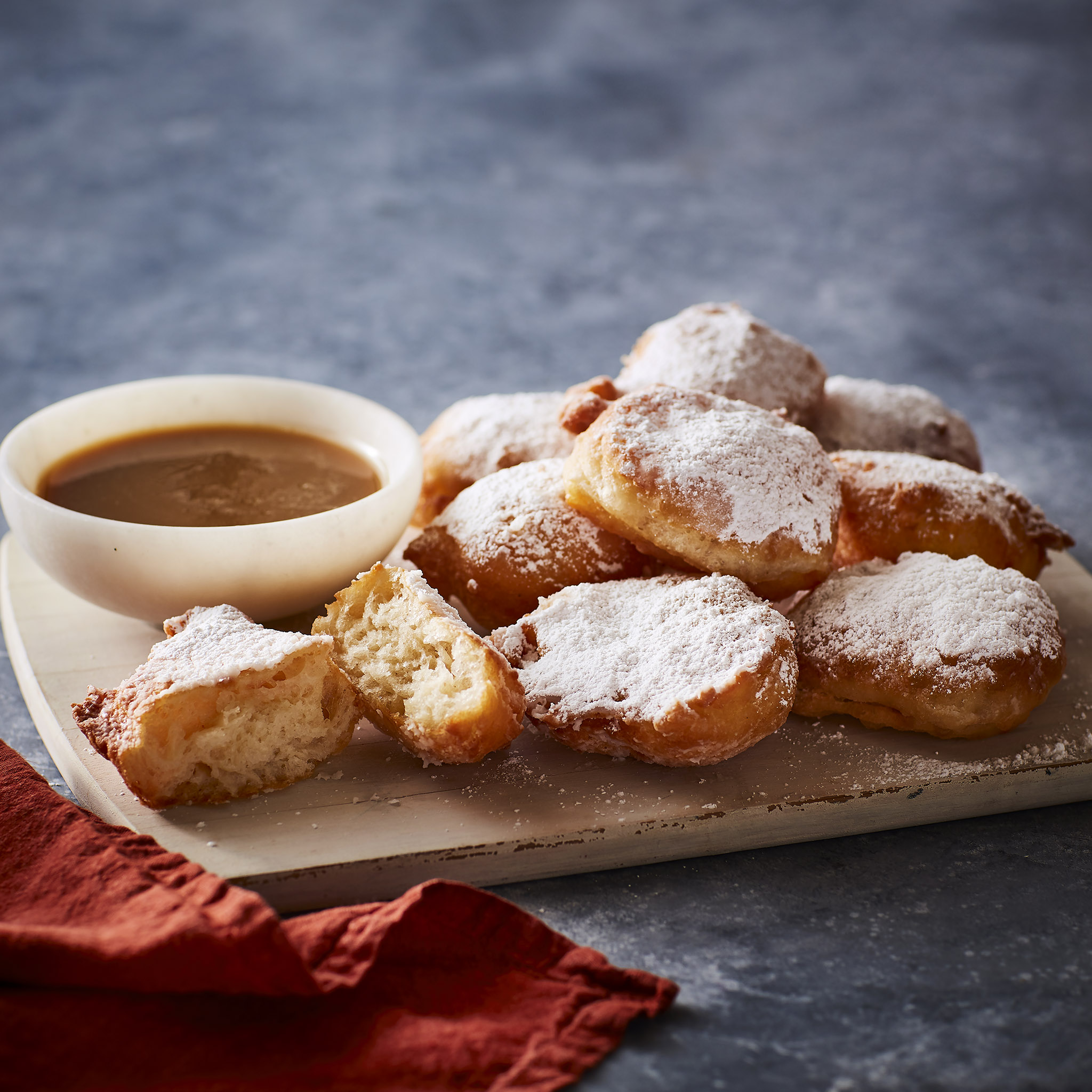Enjoy the final weeks of summer + shop our seasonal collection before we say so long. Find it here.
Set the tone with a fresh coat of paint. Shop Magnolia Home Paint.
This just in: a new season of Magnolia Table with Joanna Gaines. Learn more.

Beignets with Cafe Au Lait Chocolate
Total 23 hours (includes resting and rising times)
Active 60 mins
Makes 6 to 8 servings
TIP: If you don’t want to make all of the beignets at once, cut the dough in half and put the other half, covered well in plastic wrap, in the fridge for up to 2 days.
Ingredients
Levain Build
Final Dough Mix
Cafe Au Lait Chocolate Sauce
Directions
- You can opt to use a stand mixer to make a good, strong dough as I did. Alternatively, you can hand mix and still get fantastic results. I will add to each step what you need to do if hand mixing.
- For the Levain build: Mix the sourdough starter, bread flour, granulated sugar, and 150 grams (1/2 cup) water together in a medium bowl. Cover the bowl with a clean towel and set aside in a warm place for 3 to 5 hours.
- The levain build will be ready to mix into the final dough in 3 to 5 hours, depending on your ambient temperature. You're looking for a bubbly surface and a weblike structure when it's pulled apart.
- In a stand mixer fitted with a dough hook, combine the milk, 1/2 cup water, and the levain. Stir gently to dissolve the levain — it’s ok if it doesn't dissolve completely — 2 to 3 minutes. Add the all-purpose and bread flours, eggs, granulated sugar, vanilla, and salt to the bowl.
- With the mixer on medium-low speed, mix until the flour is completely incorporated, about 5 minutes. Alternatively, if hand mixing, simply add the flour mixture a little at a time while you use your hands to incorporate the ingredients. You should hand-mix/stretch the dough for 5 to 8 minutes.
- After the flour is incorporated, add in the melted butter and put the mixer on your second highest speed. Let it mix until it is strong, smooth, elastic, and shiny, 10 to 12 minutes. The dough will still be looser than a standard bread dough, so don’t be alarmed if yours isn’t easy to knead. Alternatively, if hand mixing, knead the dough with the palm of your hand. If the dough is too wet, use a slap-and-fold technique (slap the dough onto an oiled work surface, then fold it over itself, rotating a few times). What you're looking for is a smooth surface and a strong dough that passes the windowpane test.
- Once your dough is done mixing or kneading, allow it to bulk ferment in a covered, oiled bowl for about 6 hours in an environment that is 72°F to 75°F.
- After the bulk fermentation is complete, put the dough into the fridge overnight (8 to 10 hours). What you're looking for is a smooth, bubbly surface, some size increase in the dough, and a web-like structure beginning to develop. I like to put it in the fridge to slow down fermentation and develop more flavor. My fridge temperature usually ranges from 37°F to 43°F degrees.
- Flour your work surface and dump out your dough. Pat down into a rectangle that is about 1/2 inch thick. This is just a rough estimate. You will stretch it comfortably into a rectangle (about 11-by-17 inches) without overworking or breaking the dough.
- Use a knife or pizza cutter to cut the dough into 2-inch squares, then let it proof for 20 to 30 minutes.
- While the dough is proofing, bring 2 inches of water to a simmer in a small saucepan over medium heat. Add the chocolate, cream, and cold brew to a heat-proof glass bowl and place over the simmering water, making sure the bottom of the bowl doesn’t touch the water. Stir until completely melted and transfer to a serving bowl or pitcher.
- Fill a large Dutch oven or cast-iron pot with 2 to 3 inches of vegetable oil. (I use 1.5 liters of vegetable oil). Heat to between 350°F and 375°F.
- If your squares get a little too slack, pop them in the fridge to help them firm up before frying.
- Once your oil is at temperature, you can add 5 dough squares at a time to the oil. Your dough should not sink! You want to see them float in the oil as soon as they are dropped.
- Fry them until they are a deep golden brown, about 3 minutes per side, but take note that some of them will start flipping by themselves as they expand in the oil. This is a good thing because it means your dough is very active and it is becoming light and airy on the inside.
- Once your beignets are done frying, toss them in a large bowl of powdered sugar and turn to cover them liberally. Alternatively, pop the beignets in a brown bag full of powdered sugar and shake it up to coat.
- These bad boys are best eaten immediately after you put sugar on them! So don't wait! Serve them with the cafe au lait sauce for dipping. You can drop your next batch and start eating the first.